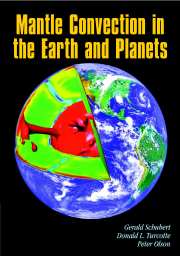Book contents
- Frontmatter
- Contents
- Preface
- 1 Historical Background
- 2 Plate Tectonics
- 3 Structure and Composition of the Mantle
- 4 Mantle Temperatures and Thermodynamic Properties
- 5 Viscosity of the Mantle
- 6 Basic Equations
- 7 Linear Stability
- 8 Approximate Solutions
- 9 Calculations of Convection in Two Dimensions
- 10 Numerical Models of Three-dimensional Convection
- 11 Hot Spots and Mantle Plumes
- 12 Chemical Geodynamics
- 13 Thermal History of the Earth
- 14 Convection in the Interiors of Solid Planets and Moons
- 15 Nature of Convection in the Mantle
- References
- Appendix: Table of Variables
- Author Index
- Subject Index
11 - Hot Spots and Mantle Plumes
Published online by Cambridge University Press: 15 December 2009
- Frontmatter
- Contents
- Preface
- 1 Historical Background
- 2 Plate Tectonics
- 3 Structure and Composition of the Mantle
- 4 Mantle Temperatures and Thermodynamic Properties
- 5 Viscosity of the Mantle
- 6 Basic Equations
- 7 Linear Stability
- 8 Approximate Solutions
- 9 Calculations of Convection in Two Dimensions
- 10 Numerical Models of Three-dimensional Convection
- 11 Hot Spots and Mantle Plumes
- 12 Chemical Geodynamics
- 13 Thermal History of the Earth
- 14 Convection in the Interiors of Solid Planets and Moons
- 15 Nature of Convection in the Mantle
- References
- Appendix: Table of Variables
- Author Index
- Subject Index
Summary
Introduction
Hot spots are anomalous areas of surface volcanism that cannot be directly associated with plate tectonic processes. The term hot spot is used rather loosely. It is often applied to any long-lived volcanic center that is not part of the global network of mid-ocean ridges and island arcs. The classic example is Hawaii. Anomalous regions of thick crust on ocean ridges are also considered to be hot spots. The prototype example is Iceland.
There is little agreement on the total number of hot spots. Several hot spot lists have been published, and the number of volcanic centers included on these lists ranges from about 20 to more than 100. In one of his original papers associating hot spots with mantle plumes, Morgan (1972) listed 19 hot spots. Crough and Jurdy (1980) listed 42,Wilson (1973) listed 66, and Vogt (1981) listed 117. Table 11.1 gives the coordinates of 30 hot spots from the list of Crough and Jurdy (1980), and Figure 11.1 shows the locations of 20 prominent hot spots (see also Figure 2.23). In many cases hot spots have well-defined tracks associated with volcanic ridges or lines of volcanic edifices; these are also shown in Figure 11.1 and in Figure 2.23. A few hot spots and the tracks they have made appear on all lists, either because of high eruption rates in the recent past or because they have produced conspicuous traces. Among these are Hawaii, Iceland, Reunion, Cape Verde, and the Azores. Others, such as Bermuda, do not have an extensive volcanic history, but qualify as hot spots because they sit atop broad topographic rises or seafloor swells.
- Type
- Chapter
- Information
- Mantle Convection in the Earth and Planets , pp. 499 - 546Publisher: Cambridge University PressPrint publication year: 2001
- 1
- Cited by



